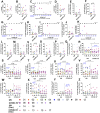Lung-resident SARS-CoV-2 peptide-specific immune responses in perfused 3D human lung explant models
- PMID: 40698364
- PMCID: PMC12279861
- DOI: 10.3389/fbioe.2025.1587080
Lung-resident SARS-CoV-2 peptide-specific immune responses in perfused 3D human lung explant models
Abstract
Introduction: Multi-specific and long-lasting T-cell immunity has been recognized to indicate long-term protection against pathogens, including the novel coronavirus, SARS-CoV-2, which is the causative agent of the COVID-19 pandemic. Functional significance of peripheral memory T cells in individuals recovered from COVID-19 (COVID-19+) is beginning to be appreciated; however, the role of lung tissue-resident memory (lung TRM) T cells in SARS-CoV-2 infection is still being investigated. This is, in part, due to the lack of preclinical tissue models available to follow the convalescence period.
Methods: Here, we utilize a perfused three-dimensional (3D) human lung-tissue model and show pre-existing local T-cell immunity against SARS-CoV-2 proteins in lung tissues.
Results: We report ex vivo maintenance of functional multi-specific IFN-γ-secreting lung TRM T cells in COVID-19+ and their induction in lung tissues of vaccinated COVID-19+ subjects. Importantly, we identify SARS-CoV-2 peptide-responding memory B cells and IgA+ plasma cells in ex vivo cultured lung tissues of COVID-19+. Furthermore, lung tissue IgA levels were increased in COVID-19+ and responded to peptide stimulation.
Discussion: In our study, we highlight the importance of utilization of human lung-tissue models to understand the local antiviral immune response in the lung to protect against SARS-CoV-2 infection.
Keywords: COVID-19; SARS-CoV-2 infection; human lung-tissue model; local antiviral immune response; perfused lung explant.
Copyright © 2025 Goliwas, Wood, Simmons, Khan, Khan, Wang, Ramachandran, Berry, Athar, Mobley, Kim, Thannickal, Harrod, Donahue and Deshane.
Conflict of interest statement
The authors declare that the research was conducted in the absence of any commercial or financial relationships that could be construed as a potential conflict of interest.
Figures




Similar articles
-
Local SARS-CoV-2 Peptide-Specific Immune Responses in Lungs of Convalescent and Uninfected Human Subjects.medRxiv [Preprint]. 2022 Jan 21:2021.09.02.21263042. doi: 10.1101/2021.09.02.21263042. medRxiv. 2022. PMID: 34518842 Free PMC article. Preprint.
-
Type I and Type III Interferons Restrict SARS-CoV-2 Infection of Human Airway Epithelial Cultures.J Virol. 2020 Sep 15;94(19):e00985-20. doi: 10.1128/JVI.00985-20. Print 2020 Sep 15. J Virol. 2020. PMID: 32699094 Free PMC article.
-
Antibody tests for identification of current and past infection with SARS-CoV-2.Cochrane Database Syst Rev. 2022 Nov 17;11(11):CD013652. doi: 10.1002/14651858.CD013652.pub2. Cochrane Database Syst Rev. 2022. PMID: 36394900 Free PMC article.
-
Detectable SARS-CoV-2 specific immune responses in recovered unvaccinated individuals 250 days post wild type infection.PLoS One. 2025 Jun 11;20(6):e0325923. doi: 10.1371/journal.pone.0325923. eCollection 2025. PLoS One. 2025. PMID: 40498720 Free PMC article.
-
Rapid, point-of-care antigen tests for diagnosis of SARS-CoV-2 infection.Cochrane Database Syst Rev. 2022 Jul 22;7(7):CD013705. doi: 10.1002/14651858.CD013705.pub3. Cochrane Database Syst Rev. 2022. PMID: 35866452 Free PMC article.
References
-
- Biospace (2020). Enzo announces issuance of U.S. Patent for methods of using proprietary compound SK1-I in patients; exploring options for development as a potential treatment for COVID-19. Farmingdale, NY: Enzo Biochem, Inc. Available online at: https://www.biospace.com/article/releases/enzo-announces-issuance-of-u-s....
-
- Boppana S., Qin K., Files J. K., Russell R. M., Stoltz R., Bibollet-Ruche F., et al. (2021). SARS-CoV-2-specific circulating T follicular helper cells correlate with neutralizing antibodies and increase during early convalescence. PLoS Pathog. 17, e1009761. 10.1371/journal.ppat.1009761 - DOI - PMC - PubMed
LinkOut - more resources
Full Text Sources
Miscellaneous

